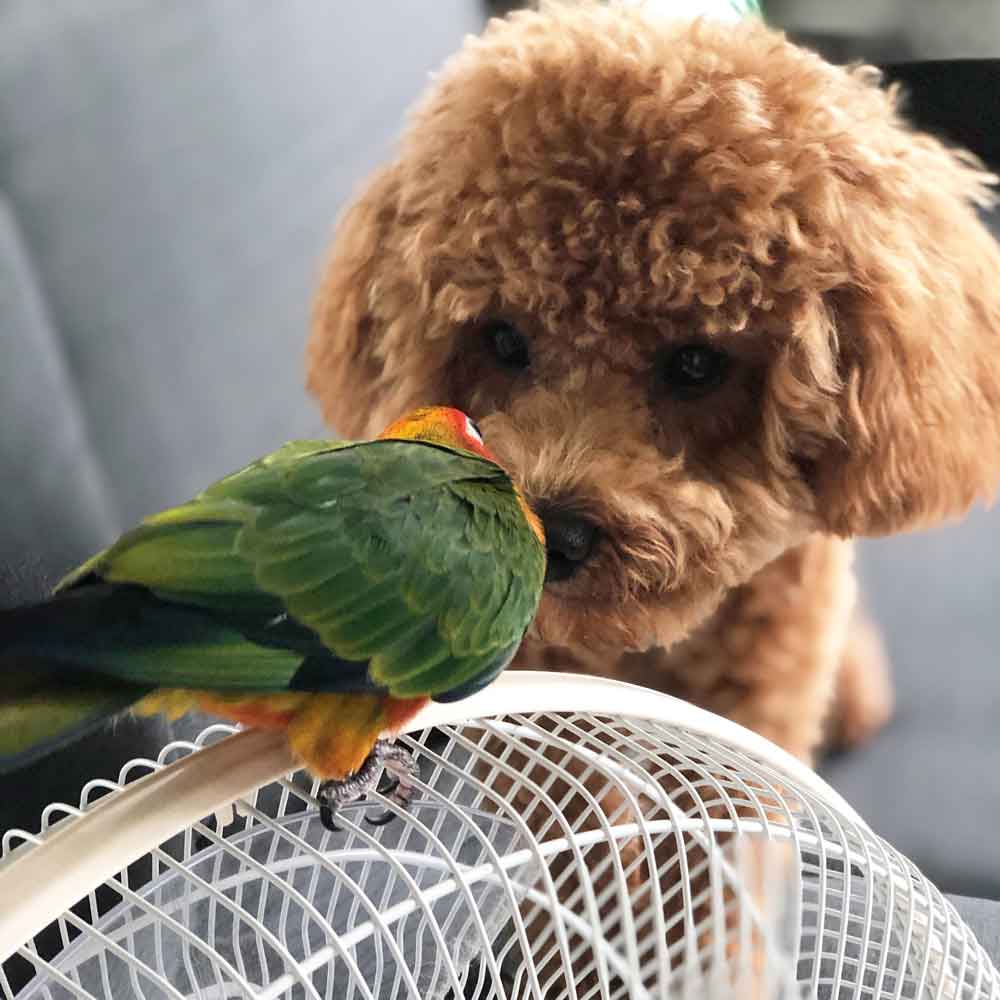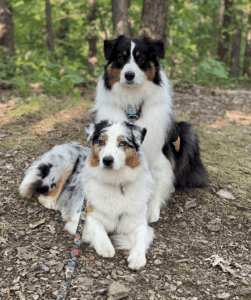Key Takeaways
-
Poodles can show signs of anxiety, such as pacing or whining, when around parrots due to their natural instincts.
-
Creating a designated safe space for your parrot and a personal retreat for your poodle is essential for reducing stress.
-
Introduce your poodle to your parrot gradually, using distraction techniques and positive reinforcement to build a peaceful relationship.
-
Calming aids like pheromone diffusers and soothing music can help alleviate your poodle’s anxiety.
-
If your poodle’s anxiety persists, it’s important to consult with a veterinarian or an animal behaviorist for professional advice.
Understanding Your Poodle’s Anxiety Around Parrots
Have you ever noticed your poodle getting jittery around your parrot? Maybe they pace back and forth, whine, or even bark incessantly. It’s not just quirky behavior; it’s likely a sign of anxiety. And you’re not alone in this; many poodle owners witness similar reactions when their furry friends encounter feathered ones. So let’s dive into why this happens and how you can create harmony in your pet-filled home.

“How To Socialize Your Dog And Parrot …” from www.poodlesandparrots.com and used with no modifications.
Recognizing Signs of Stress in Poodles
First things first, identifying if your poodle is stressed is crucial. Look for these tell-tale signs:
-
Pacing or restlessness
-
Whining or barking at the parrot
-
Hiding or avoidance behavior
-
Excessive licking or chewing on themselves
-
Changes in body posture, like a tucked tail or flattened ears
Understanding these signals is the first step to addressing the issue. It’s like putting together a puzzle; each piece of behavior tells us something about what your poodle is feeling.
Why Parrots Might Trigger Anxiety in Dogs
Parrots are colorful, vocal, and often unpredictable – all things that can be confusing or even alarming to a dog. Poodles, despite their intelligence, may not understand these feathered creatures. Here’s why:
-
Natural instincts: Dogs have a prey drive, and the fluttering and squawking of a parrot might trigger this instinct.
-
Lack of socialization: If a poodle isn’t used to being around birds, they might be uncertain how to act, leading to anxiety.
-
Jealousy: Poodles are known for their strong bond with their owners. If they feel that a parrot is receiving more attention, this can cause stress.
By understanding these triggers, you can tailor your approach to calming your poodle effectively.
Creating a Safe Space for Each Pet
Just like humans, pets need their own safe spaces to retreat to when they’re feeling overwhelmed. This is even more important in a household with multiple species.
Designating a Dog-Free Zone for Your Parrot
Parrots are sensitive creatures that thrive in a stable environment. To keep your parrot calm and reduce its stress levels:
-
Set up the birdcage in a quiet area where your poodle doesn’t usually go.
-
Make sure the cage is high enough so your parrot feels secure from ground-level threats.
-
Provide plenty of toys and perches for mental stimulation and comfort.
This zone will be a sanctuary for your parrot, somewhere it knows it can relax without any canine interruptions.
The Importance of Personal Retreats for Dogs
Your poodle also needs a place to unwind. Here’s how to create the perfect retreat:
-
Choose a cozy spot in your home that’s away from the parrot’s area.
-
Fill it with your poodle’s favorite bed, toys, and maybe even an item with your scent for comfort.
-
Ensure this area is quiet and can be a consistent spot for your poodle to associate with relaxation.
When each pet has their own safe space, they can take a break from each other, reducing the chances of stress and anxiety.
Introducing Distraction Techniques
When it comes to easing your poodle’s anxiety around your parrot, distraction can be a key tactic. The goal is to redirect your poodle’s focus away from the parrot and towards something positive and engaging. You can try engaging play therapy techniques.
-
Tossing a favorite toy for your poodle to fetch when they start to fixate on the parrot.
-
Initiating a training session with commands your poodle knows well, rewarding them with treats for their attention and compliance.
-
Providing a puzzle feeder filled with treats to keep your poodle’s mind occupied.
Consistency with these distractions will help your poodle form a new association with the parrot’s presence: instead of feeling anxious, they’ll learn to expect playtime or treats. For more tips on socializing traumatized rescue dogs, check out our guide.
Positive Reinforcement Strategies
Positive reinforcement is about rewarding your poodle for calm behavior around the parrot. Here’s how to implement this approach: consider socialization tips for shy rescue dogs which can also be applied to help your poodle adjust to the presence of a parrot.
Keep treats handy and give one to your poodle when they’re calm and not fixating on the parrot. This reinforces the idea that being relaxed is beneficial. Over time, your poodle will associate the parrot with good things rather than something to be anxious about.
Also, celebrate the small victories. If your poodle looks at the parrot but then looks away without getting worked up, that’s a win. Make a big deal out of it with praise and a treat. It’s these moments that build up to a big change in behavior.
Remember, patience is key. This isn’t an overnight fix but a gradual training process. With time, your poodle will learn that staying calm around the parrot is the best way to get your attention and those tasty treats they love.
Calming Aids and Tools
In addition to training, there are products specifically designed to help reduce pet anxiety. Let’s explore some options that could help your poodle feel more at ease around your parrot.
Exploring Pheromone Diffusers
-
Pheromone diffusers release a synthetic version of the calming pheromones produced by mother dogs to comfort their puppies.
-
These can be plugged in near your poodle’s personal retreat to create a calming atmosphere.
-
There are also pheromone collars and sprays that can be used for a more direct approach.
Pheromone products are widely regarded as safe and can be an excellent supplement to your training efforts. They subtly alter the mood without the need for medication or invasive techniques.
It’s important to note that not all dogs respond to pheromone products, but for those that do, they can be a game-changer in managing anxiety.
The Role of Soothing Music and Sounds
Just like humans, dogs can be calmed by the sound of music. Playing classical music or specially designed pet relaxation tracks can help soothe your poodle’s nerves. Here’s what you can do:
-
Play music at a low volume in the area where your poodle spends most of their time.
-
Choose melodies that are slow and soft, as these are most likely to have a calming effect on your dog.
-
Observe your poodle’s reaction to different types of music to find what works best for them.
By incorporating calming sounds into your poodle’s environment, you can help create a more peaceful atmosphere for both your poodle and your parrot.
Professional Interventions
If you’ve tried the above strategies and your poodle’s anxiety around parrots persists, it might be time to seek professional help. An expert’s guidance can be invaluable in these situations.
When to Consult a Veterinarian or Animal Behaviorist
Consider consulting a professional if:
-
Your poodle’s anxiety is severe and not improving with home interventions.
-
The anxiety is leading to destructive behavior or aggression.
-
You feel overwhelmed and unsure how to proceed with training.
A veterinarian can rule out any medical causes of anxiety and discuss the possibility of medication or supplements. An animal behaviorist can provide specialized training to address your poodle’s specific needs.
Dog Anxiety Medications: Pros and Cons
Medication can be a powerful tool in managing anxiety in dogs, but it’s not a decision to take lightly. Here are some points to consider:
Pros:
-
Medication can provide relief for a dog who is severely anxious and improve their quality of life.
-
It can be used in conjunction with behavior modification techniques for better results.
-
Some medications can be used on an as-needed basis for predictable anxiety triggers.
Cons:
-
Medications can have side effects, such as drowsiness or changes in appetite.
-
They may not address the underlying cause of anxiety and are often more effective when used in combination with training.
-
There can be a trial-and-error process to find the right medication and dosage for your dog.
Discussing these options with your vet will help you make an informed decision about what’s best for your poodle.
Frequently Asked Questions (FAQ)
As a pet owner, you’re bound to have questions. Here are answers to some common queries about poodles, parrots, and anxiety.
How can I tell if my poodle is anxious or just excited around parrots?
Anxiety and excitement can sometimes look similar in dogs, but there are key differences. An anxious poodle might have a stiff body, avoid eye contact, and might even try to hide. Excitement, on the other hand, is usually accompanied by wagging tails, playful barks, and a generally more relaxed body language. Pay attention to these cues to understand how your poodle truly feels around your parrot.
Are there specific breeds of birds more prone to anxiety around dogs?
Just like dogs, certain bird breeds can be more sensitive. African Greys, for example, are known for their intelligence but can be prone to anxiety. Cockatiels and parakeets might also get stressed easily due to their smaller size and more delicate nature. Larger birds like macaws may be less intimidated by dogs, but individual personalities vary widely. It’s important to consider the bird’s background and experiences with dogs when assessing their comfort level.
Regardless of breed, all birds require a sense of security. Introduce any interactions with dogs slowly and under controlled conditions to minimize stress for both animals.
Remember, the key to a successful introduction is patience and observation. Watch for signs of distress in your bird, such as feather plucking, changes in eating habits, or excessive screaming. These can be indicators that the presence of a dog is causing anxiety.
It’s essential to prioritize the well-being of both your poodle and your parrot. If you notice any negative changes in behavior, it’s time to reassess their interactions and possibly separate them to give each pet their own space.
Can parrots and poodles ever be friends, or is it always stressful for the dog?
Friendship between parrots and poodles is certainly possible! It largely depends on the individual animals and how they’re introduced to each other. Here are a few tips to foster a friendly relationship:
-
Always supervise interactions between your poodle and parrot, especially in the early stages.
-
Encourage calm behavior by rewarding both pets when they’re relaxed in each other’s presence.
-
Ensure both pets have their own space to retreat to when they need a break.
By taking these steps, you can help create a peaceful environment where both your poodle and parrot feel comfortable and secure.
What should I do if my poodle’s anxiety around parrots doesn’t improve?
If your poodle’s anxiety around parrots doesn’t show signs of improvement despite your best efforts, it’s time to seek professional help. A veterinarian can check for any underlying health issues, while an animal behaviorist can work with you to develop a customized training plan.
Don’t be discouraged if progress seems slow. Anxiety can be a complex issue to navigate, and sometimes a professional perspective is what’s needed to make breakthroughs. Remember, you’re not alone in this, and there are resources and experts who can help guide you and your poodle toward a more relaxed relationship with your parrot.
Keep track of your poodle’s behavior in a journal, noting what seems to trigger anxiety and what calms them down. This information will be incredibly useful for any professional you consult.
Also, consider if there have been any changes in the household routine. Dogs are creatures of habit, and even small changes can cause stress. Make sure your poodle has a consistent schedule, which can be a source of comfort for them.
Most importantly, ensure that your poodle is getting enough physical and mental exercise. A tired dog is generally a happy dog, and exercise is a natural stress-reliever.
Are there any calming treats that are safe for poodles and effective against anxiety?
Yes, there are calming treats formulated specifically for dogs to help manage stress and anxiety. When choosing a calming treat for your poodle, look for these ingredients:
-
L-Theanine: An amino acid found in green tea that promotes relaxation without drowsiness.
-
Chamomile and Valerian Root: Herbs known for their soothing properties.
-
Trytophan: An amino acid that helps increase serotonin levels, improving mood and sleep.
Always check with your veterinarian before introducing a new supplement or treat into your poodle’s diet. They can help you choose a product that’s safe and effective for your dog’s specific needs.
Remember to follow the dosage instructions on the treat packaging, and monitor your poodle for any changes in behavior or health. While calming treats can be helpful, they’re most effective when used in conjunction with the training and environmental changes we’ve discussed.
Creating a peaceful environment for your poodle and parrot takes time and patience, but it’s a rewarding journey. With the right strategies and support, you can help your pets live together in harmony, ensuring a happy, stress-free home for everyone.


